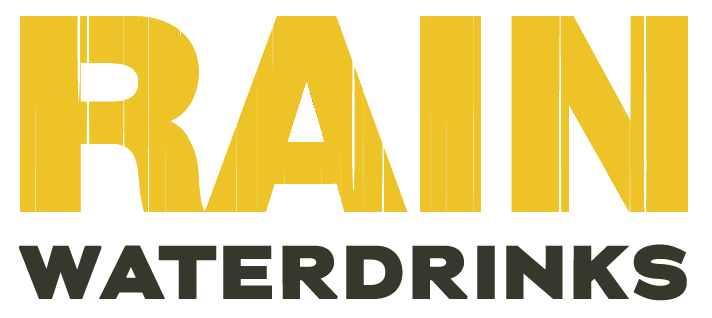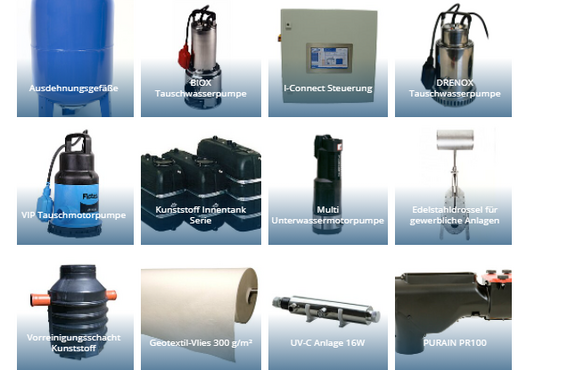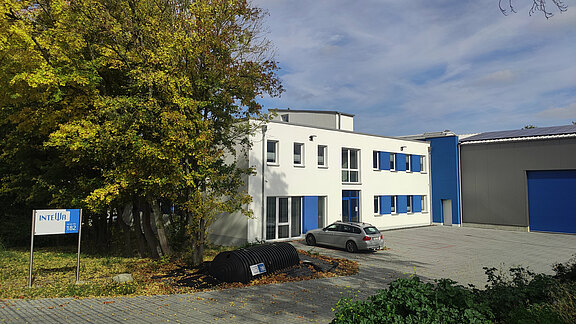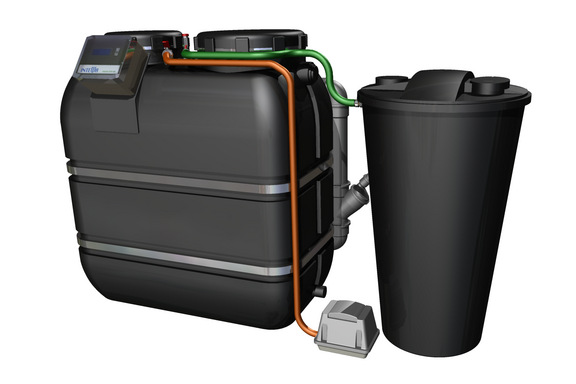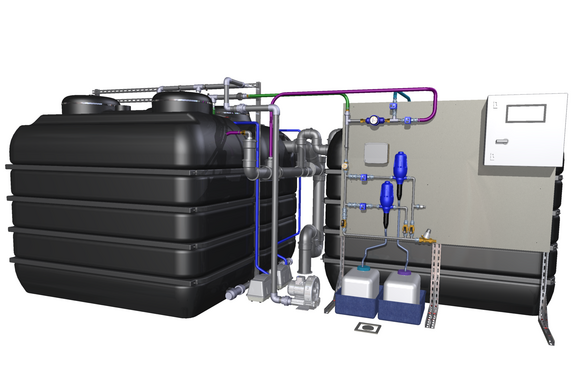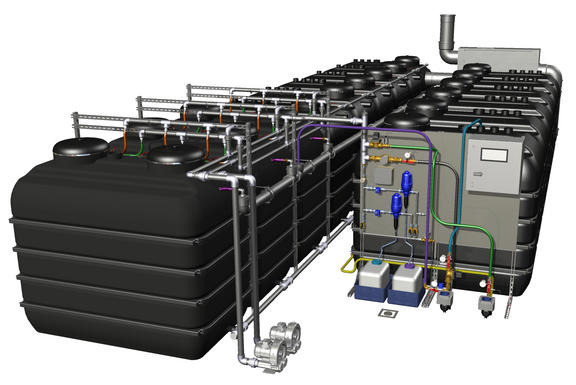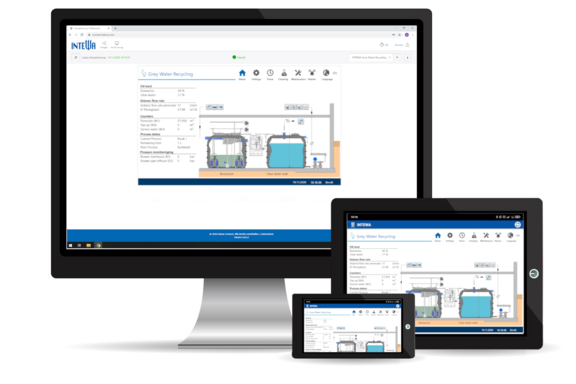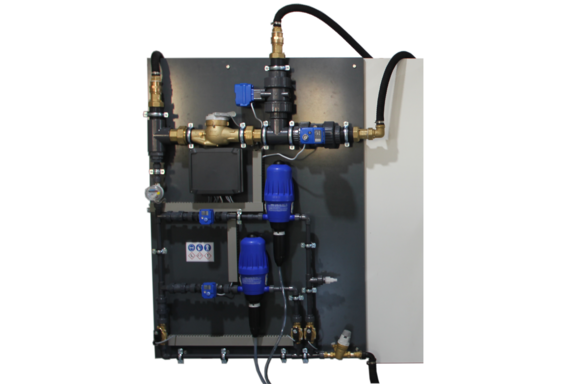Greywater recycling as a profit generator for new construction and renovation
The search for sustainable solutions in the field of water supply in order to minimize the costs of the constantly increasing water prices and to prevent the threatening scarcity of resources has gained immense importance.
A building should be viewed as a whole complex and thus as such should be subjected to sustainable change in a holistic manner. This is particularly important when it comes to water, as more and more buildings are integrating green roofs, facades or plants. Where should the water for irrigation come from, especially as it is becoming increasingly scarce due to climatic conditions?
A water source that is currently gaining in relevance can provide the solution here: So-called greywater recycling. In this process, slightly contaminated water from showers, bathtubs and washbasins is treated and reused mostly for toilet flushing and irrigation.
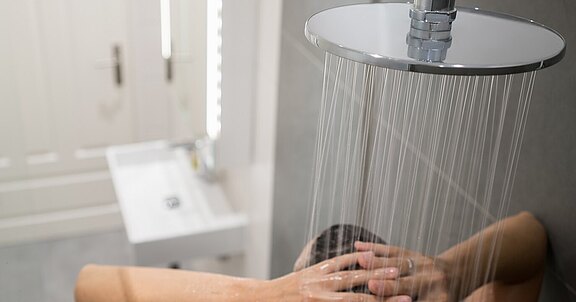
This solution is not only extremely sustainable, but also economically profitable, because for many properties, such as apartment buildings or hotels from about 100 people, such a system already pays for itself within less than 6 years (at drinking and waste water costs of 6.00 € / m³). But also for smaller objects this technology offers various advantages and should become in the future for each planner and owner a matter of course. The Aachen-based company INTEWA has perfected the technology to such an extent over the past 10 years and has successfully implemented it in over 100 projects worldwide that the recycling of greywater is long out of the initiation phase and on its way to becoming an integral part of modern, sustainable building technology.
How does a greywater recycling plant work?
The greywater from showers, bathtubs and hand basins is pre-filtered via a highly efficient filter before it enters the bioreactor. The dirt collected in the prefilter is regularly flushed back into the sewer by means of a backflushing nozzle. In the core of the plant, the bioreactor, continuous biodegradation takes place by means of bacteria. These are supplied with oxygen through a tubular diffuser located at the bottom of the plant. The bacteria settle on the many hundreds of packed beds, which are special suspended bodies with a large surface area. A sludge pump, which is also located at the bottom, periodically removes the sediments. The bioreactor also contains the membrane stations, which filter the greywater into the clear water reservoir by means of ultrafiltration. Due to the small membrane pore width of 0.02 µm, particles, bacteria and even viruses are retained.
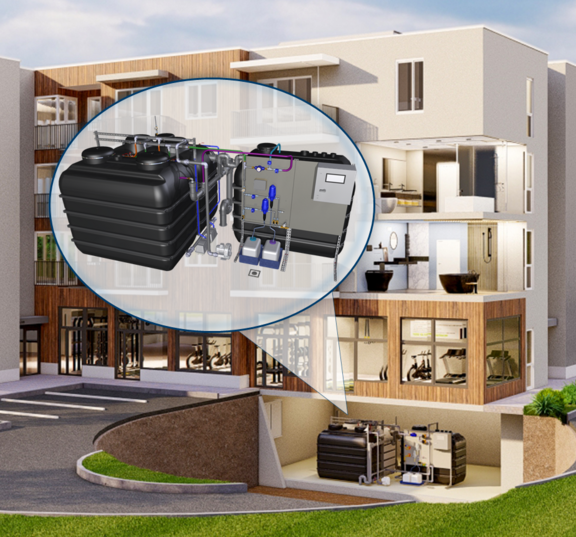
The membranes are periodically cleaned by backwashing and by coarse air bubbles. Systems > 5,400 l/day treatment volume, are equipped with browser capable control and automatic chemical cleaning technology. This enables even more economical and low-maintenance operation, especially for the larger systems. Smaller systems, on the other hand, are equipped with the triple membrane surface to minimize the required maintenance intervals.
The clean, hygienically treated service water is pumped by booster systems to the consumers and used for toilet flushing, washing machines or irrigation. To achieve the highest possible level of safety, the already ultrafiltrated process water undergoes UV treatment as a final stage.
Where are greywater recycling plants particularly suitable?
Especially in sports facilities, schools, hotels and apartment buildings with increased water consumption due to showers and bathing and a matching service water demand for toilet flushing, washing machines or irrigation, greywater recycling plants are excellently suited, as here the efficiency of the plants is shown to its best advantage. But also in many office buildings it is very suitable to treat and reuse the water from hand wash basins in this way.
Other enormous advantages of greywater systems are that - unlike rainwater harvesting systems - they are independent of roof surfaces and precipitation conditions and are therefore not subject to strong fluctuations during the course of a year! In addition, greywater profit and demand automatically show a high degree of coverage over time. This enables particularly profitable and efficient use, because during vacation periods, when less water is needed, for example, less water is produced. Only a correspondingly small amount of water is treated. Since a separate greywater and process water piping system is required for greywater recycling plants, new buildings or renovation projects are usually suitable. Here, the separate pipelines cause justifiable additional costs. To allow good accessibility and maintenance of the plant, the installation of the plant should be inside the building.
What are the reasons for using a greywater recycling plant?
Save water
The treatment and use of greywater is the most efficient solution for reducing drinking water consumption in large buildings. This is crucial because, in view of constantly rising costs in conventional drinking water supply and wastewater disposal, saving the valuable resource of water is becoming increasingly important. Here, greywater recycling is the appropriate technology to generate a new source of water. After all, what could be more obvious than to clean the used water by means of state-of-the-art technology and thus make it usable again?
Save money
Dual use also results in dual financial gain: Both drinking water and wastewater charges are saved. In many countries, drinking water and wastewater costs together already exceed €6.00/m³. Depending on the water price and the size of the system, very short payback periods can now be achieved, making the use of a greywater recycling system one of the most economical technologies in the construction sector.
Example calculation based on a 10,800 l/day system
| Plant costs | approx. 4.600,00 € / m³ |
Greywater and process water piping system | approx.3.000,00 € / m³ |
| Costs basement floor space* | approx. 500,00 € / m³ |
| Savings of drinking water and waste water | approx. 6,00 € / m³ / day |
| Operating and maintenance costs | approx. 1,00 € / m³ / day |
| Static amortization | approx. 4,4 years |
*for 1 m³ treatment volume about 1 m² installation area is needed.
Achieve sustainable building standards
With a greywater recycling system, building owners and planners make a significant contribution to achieving the United Nations' sustainability goals by saving water and wastewater.
Increasing the value of the building
By integrating a greywater system, a higher classification can be achieved in building certification (e.g. with the DGNB, LEED, BREEAM and many more). In addition, financing advantages due to the EU taxonomy and sustainability classification ensure that the building can be classified as a sustainable financial investment (ESG).
Small space requirement
Greywater systems are extremely space-saving, as the water is produced daily and can be reused directly. This eliminates the need for larger storage capacities, which is a distinct advantage over other systems. One cubic meter of water for daily use can be stored in one square meter of space.
How good and safe is the water quality of the treated greywater?
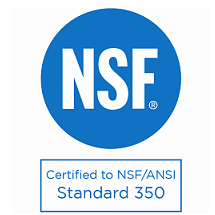
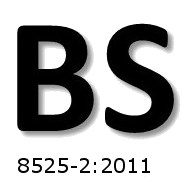
Thanks to the special treatment process with a membrane bioreactor, which includes both biological degradation and ultrafiltration with a pore size of 0.02 µm, the systems deliver excellent water quality that meets the highest standards. Compared to other processes, even germs and viruses are safely retained here. The INTEWA systems are the first and so far only systems worldwide to be certified according to the important NSF "Class C" standard. In addition, the systems have been certified according to the British Standard for spray irrigation.
Dimensioning, planning and installation
The dimensioning of a greywater system is based on the daily demand and daily yield. Meanwhile INTEWA offers a series of prefabricated systems from 300 to 48,600 liters treatment volume/day:
AL-GW300 to AL-GW3600 systems are equipped with an AQUALOOP control system.
The larger systems AL-GW5400 to AL-GW21,600 have a remote control with I-CONNECT and automatic cleaning I-CON-ADS.
The AL-GW32400 to AL-GW48600 systems also have a central filtration and backwash pump in addition to I-CONNECT and I-CON-ADS.
Even larger systems are combined. The prefabricated systems can be very quickly and safely planned into a building and allow uncomplicated installation, which can be carried out quickly by any installer.
Operation and maintenance with I-CONNECT
The I-CONNECT control system is the heart of the plant and, with the appropriate accessories, enables remote monitoring and remote control of greywater treatment systems over 5,400 l/day. Online access to the respective system is provided via a web portal or an app.
The Viewer license allows viewing of the plants, the Expert license allows online configurations directly at the plant. Offline, the controllers can be operated via a touch display or computer, depending on the version. The data is hosted on secure servers in Europe. The controller allows output to common building management systems such as Bacnet.
Automatic chemical cleaning
Systems > 5,400 l/day are equipped with the so-called I-CON-ADS technology. This enables the automatic execution of a chemical cleaning of the membrane cartridges. The average flow rate of the ultrafiltration membranes can thus be tripled and the efficiency of the filtration process increased. The comprehensive cleaning process consists of acid cleaning with citric acid, which dissolves inorganic compounds (scaling) in the membrane and lines. This is supplemented by oxidative cleaning with chlorine to remove organic blockages.
References
Rancho Cienega Sports Complex, USA
In one of the largest and best known sports facilities in the USA, the "Rancho Cienega Sports Complex" (also known as the Michelle and Barack Obama Sports Complex) in Los Angeles, approx. 5,400 liters of treated shower water are used daily for toilet flushing and irrigation of the extensive sports facilities via a complete AQUALOOP greywater system.
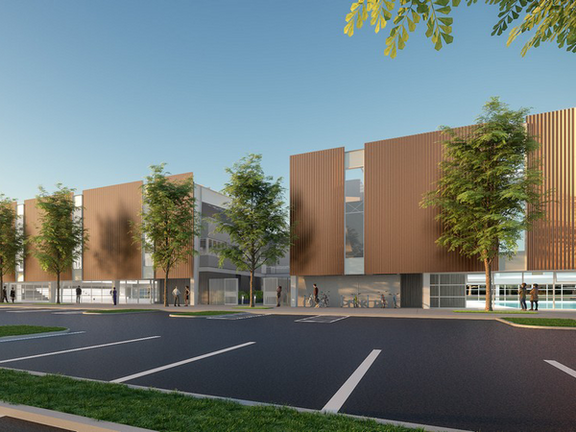
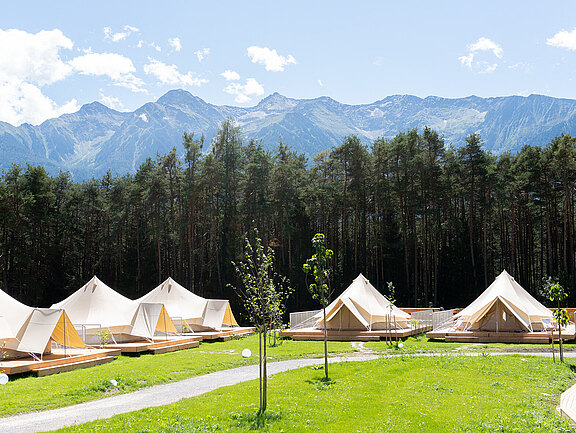
Camping Gerhardhof, Austria
The approach for this extraordinary campsite was simple: use the resources available on site while interfering as little as possible with the surrounding environment. With a 5,400 liter system, the existing grey water from showers and hand washing bakes is collected and reused for toilet flushing. With 400 to 500 visitors at a time, this can save up to 6,000 liters of water a day.
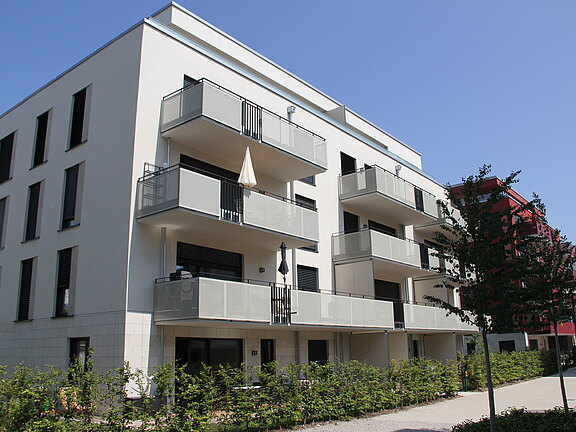
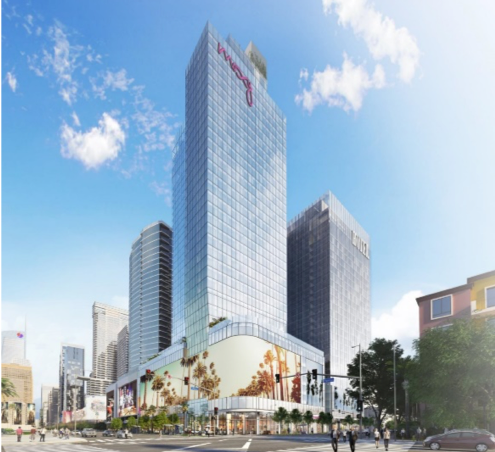
Apartment building Munich
Approximately 3,000 liters of greywater from showers, bathtubs, and hand sinks in this 32-unit apartment complex is treated with an AQUALOOP system and reused for toilet flushing and green space irrigation.
Fig & Pico, USA
A large-scale greywater recycling system will be part of The Fig + Pico project, a 42-story hotel tower currently under construction in downtown Los Angeles. In compliance with the City of Los Angeles ordinance that requires 100% of cooling tower water in any new building over 25 stories to come from non-potable water sources, the system will capture shower water from the 727 guest rooms and recycle it for the cooling tower. An average of 4,800 liters of shower water per day will be recycled.
Summary and outlook
The enormous significance and the high future-oriented potential of greywater recycling for the water supply of buildings are scientifically recognized and the economic and ecological advantages of this technology are undisputed. With the new series of ready-to-connect greywater systems, the water expert INTEWA from Aachen, Germany, demonstrates that this form of water reuse has now reached the highest technological level in modern building technology. The systems feature automatic cleaning, browser-based control and remote maintenance and can thus be operated conveniently and easily online anywhere in the world. This reduces maintenance costs and guarantees functional reliability and the resulting certified quality of the treated water, which meets the highest standards.
The systems are now not only sustainable, but can be operated extremely economically with payback periods of less than 6 years. Thus, greywater recycling systems are no longer only of interest for "green building" buildings, but even a much desired return on investment for investors.
Author: Oliver Ringelstein, INTEWA GmbH
Characters: 13,000 incl. spaces
Virtual visit of the 5,400 liter demo grey water system with 360° tour
Notice:
Modifications of the technical article are only allowed with explicit permission of the author!
*All visualizations show the current status. Changes of any kind are reserved.

